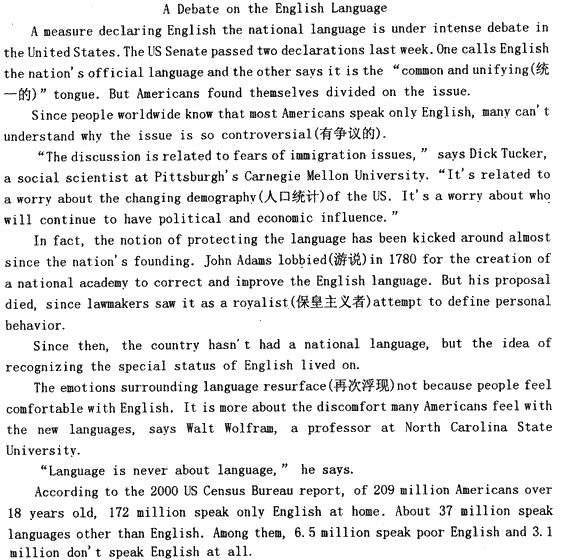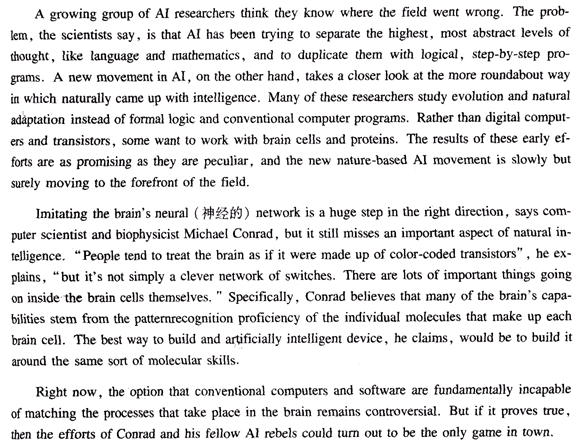 重要提示:
请勿将账号共享给其他人使用,违者账号将被封禁!
重要提示:
请勿将账号共享给其他人使用,违者账号将被封禁!
题目
In just one generation, millions of mothers have gone to work, transforming basic family economics. Scholars, policymakers, and critics of all stripes have debated the social implications of these changes, but few have looked at the side effect family risk has risen as well. Today's families have budgeted to the limits of their new two-paycheck status. As a result they have lost the parachute they once had in times of financial setback- a back-up earner (usually Mom) who could go into the workforce if the primary earner got laid off or fell sick. This “added-worker effect” could support the safety net offered by unemployment insurance or disability insurance to help families weather bad times. But today, a disruption to family fortunes can not longer be made up with extra income from an otherwise-stay-at-home partner.
During the same period, families have been asked to absorb much more risk in their retirement income. Steelworkers, airline employees, and now those in the auto industry are joining millions of families who must worry about interest rates, stock market fluctuation, and the harsh reality that they may outlive their retirement money. For much of the past year. President Bush campaigned to move Social Security to a savings-account model, with retirees trading much or all of their guaranteed payments for payments depending on investment returns. For younger families, the picture is not any better. Both the absolute cost of healthcare and the share of it borne by families have risen-and newly fashionable health-savings plans are spreading from legislative halls to Wal-Mart workers, with much higher deductibles and a large new does of investment risk for families‘ future healthcare. Even demographics are working against the middle class family, as the odds of having a weak elderly parent- and all the attendant need for physical and financial assistance have jumped eightfold in just one generation.
From the middle-class family perspective, much of this, understandably, looks far less like an opportunity to exercise more financial responsibility, and a good deal more like a frightening acceleration of the wholesale shift of financial risk onto their already overburdened shoulders. The financial fallout has begun, and the political fallout may not be far behind.
第31题:Today\\\'s double-income families are at greater financial risk in that
A.the safety net they used to enjoy has disappeared.
B.their chances of being laid off have greatly increased.
C.they are more vulnerable to changes in family economics.
D.they are deprived of unemployment or disability insurance.
 更多“根据下列文章,回答31~35题。During the past generation, the American middle-class family that”相关的问题
更多“根据下列文章,回答31~35题。During the past generation, the American middle-class family that”相关的问题
第1题
根据下列材料请回答 31~35 题:

第 31 题 What are the two declarations concerned with?

第2题
根据下列文章,请回答 31~35 题。
Text 3
Do you find it very difficult and painful to get up in the morning? This might be called laziness,but Dr. Kleitman has a new explanation. He has proved that everyone has a daily energy cycle.
During the hours when you labor through your work you may say that you' re "hot'. That' s true. The time of day when you feel most energetic is when your cycle of body temperature is at its peak. For some people the peak comes during the forenoon. For others it comes in the afternoon or evening. No one has discovered why this is so, but it leads to such familiar monologues as: "Get up, Peter! You'll be late for work again!" The possible explanation to the trouble is that Peter is at his temperature-and-energy peak in the evening. Much family quarrel ends when husbands and wives realize what these energy cycles mean, and which cycle each member of the family has.
You can' t change your energy cycle, but you can learn to make your life fit it better. Habit can help, Dr. Kleitman believes. Maybe you' re sleepy in the evening but feel you must stay up late any- way. Counteract your cycle to some extent by habitually staying up later than you want to. If your energy is low in the morning, but you have an important job to do early in the day, rise before your usual hour. This won' t change .your cycle, but you' 11 get up steam and work better at your low point.
Get off to a slow start which saves your energy. Get up with a leisurely yawn and stretch. Sit on the edge of the bed a minute before putting your feet on the floor. Avoid the troublesome search for clean clothes by laying them out the night before. Whenever possible, do routine work in the afternoon and save tasks requiting more energy or concentration for your sharper hours.
第 31 题 If a person finds getting up early a problem, most probably
A.he is a lazy person
B.he refuses to follow his own energy cycle
C.he is not sure when his energy is low
D.he is at his peak in the afternoon or evening
第3题
根据下列文章,回答31~35题。
During the past generation, the American middle-class family that once could count on hard work and fair play to keep itself financially secure has been transformed by economic risk and new realities. Now a pink slip, a bad diagnosis. or a disappearing spouse can reduce a family from solidly middle class to newly poor in a few months.
In just one generation, millions of mothers have gone to work, transforming basic family economics. Scholars, policymakers, and critics of all stripes have debated the social implications of these changes, but few have looked at the side effect family risk has risen as well. Today's families have budgeted to the limits of their new two-paycheck status. As a result they have lost the parachute they once had in times of financial setback- a back-up earner (usually Mom) who could go into the workforce if the primary earner got laid off or fell sick. This “added-worker effect” could support the safety net offered by unemployment insurance or disability insurance to help families weather bad times. But today, a disruption to family fortunes can not longer be made up with extra income from an otherwise-stay-at-home partner.
During the same period, families have been asked to absorb much more risk in their retirement income. Steelworkers, airline employees, and now those in the auto industry are joining millions of families who must worry about interest rates, stock market fluctuation, and the harsh reality that they may outlive their retirement money. For much of the past year. President Bush campaigned to move Social Security to a savings-account model, with retirees trading much or all of their guaranteed payments for payments depending on investment returns. For younger families, the picture is not any better. Both the absolute cost of healthcare and the share of it borne by families have risen-and newly fashionable health-savings plans are spreading from legislative halls to Wal-Mart workers, with much higher deductibles and a large new does of investment risk for families‘ future healthcare. Even demographics are working against the middle class family, as the odds of having a weak elderly parent- and all the attendant need for physical and financial assistance have jumped eightfold in just one generation.
From the middle-class family perspective, much of this, understandably, looks far less like an opportunity to exercise more financial responsibility, and a good deal more like a frightening acceleration of the wholesale shift of financial risk onto their already overburdened shoulders. The financial fallout has begun, and the political fallout may not be far behind.
第 31 题 Today's double-income families are at greater financial risk in that
A.the safety net they used to enjoy has disappeared.
B.their chances of being laid off have greatly increased.
C.they are more vulnerable to changes in family economics.
D.they are deprived of unemployment or disability insurance.
第4题
根据下列材料请回答 31~35 题:
A
Now satellites are helping to forecast the weather.They are in space,and they can reach any part of the world.The satellites take pictures of the atmosphere(大气),because this is where the weather form.They send these pictures to the weather stations.So meteorologists(气象学家)can see the weather of any part of the world.From the pictures,the scientists can often say how the weather will change.
Today,nearly five hundred weather stations in sixty countries receive satellite pictures.When they receive new pictures,the meteorologists compare them with earlier ones.Perhaps they may find that the clouds have changed during the last few hours.This may mean that the weather on the ground may soon change,too.In their next weather forecast,the meteorologists can say this.
So the weather satellites are a great help to the meteorologists.Before satellites were invented,the scientists could forecast the weather for about 24 0r 48 hours.Now they can make good forecasts for three or five days.Soon,perhaps,they may be able to forecast the weather for a week or more ahead.
第 31 题 Satellites travel______.
A.in space
B.in the atmosphere
C.above the ground
D.above space
第5题
根据下列文章,回答31~35题。
The relationship between formal education and economic growth in poor countries is widely misunderstood by economists and politicians alike. Progress in both areas is undoubtedly necessary for the social, political and intellectual development of these and all other societies; however, the conventional view that education should be one of the very highest priorities for promoting rapid economic development in poor countries is wrong. We are fortunate that is it, because building new educational systems there and putting enough people through them to improve economic performance would require two or three generations. The findings of a research institution have consistently shown that workers in all countries can be trained on the job to achieve radically higher productivity and, as a result, radically higher standards of living.
Ironically, the first evidence for this idea appeared in the United States. Not long ago, with the country entering a recessing and Japan at its prebubble peak, the U.S. workforce was derided as poorly educated and one of the primary cause of the poor U.S. economic performance. Japan was, and remains, the global leader in automotiveassembly productivity. Yet the research revealed that the U.S. factories of Honda, Nissan, and Toyota achieved about 95 percent of the productivity of their Japanese counterparts—a result of the training that U.S. workers received on the job.
More recently, while examining housing construction, the researchers discovered that illiterate, non-English-speaking Mexican workers in Houston, Texas, consistently met best-practice labor productivity standards despite the complexity of the building industry’s work.
What is the real relationship between education and economic development? We have begun to suspect that continuing economic growth promotes the development of education even when governments don’t force it. After all, that’s how education got started. When our ancestors were hunters and gatherers 10,000 years ago, they didn’t have time to wonder much about anything besides finding food. Only when humanity began to get its food in a more productive way was there time for other things.
As education improved, humanity’s productivity potential increased as well. When the competitive environment pushed our ancestors to achieve that potential, they could in turn afford more education. This increasingly high level of education is probably a necessary, but not a sufficient, condition for the complex political systems required by advanced economic performance. Thus poor countries might not be able to escape their poverty traps without political changes that may be possible only with broader formal education. A lack of formal education, however, doesn’t constrain the ability of the developing world’s workforce to substantially improve productivity for the foreseeable future. On the contrary, constraints on improving productivity explain why education isn’t developing more quickly there than it is.
第 31 题 The author holds in paragraph 1 that the importance of education in poor countries
A.is subject to groundless doubts.
B.has fallen victim of bias.
C.is conventionally downgraded.
D.has been overestimated.
第6题
根据下列文章,回答31~35题。
In the early 1960s Wilt Chamberlain was one of only three players in the National Basketball Association (NBA) listed at over seven feet. If he had played last season, however, he would have been one of 42. The bodies playing major professional sports have changed dramatically over the years, and managers have been more than willing to adjust team uniforms to fit the growing numbers of bigger, longer frames.
The trend in sports, though, may be obscuring an unrecognized reality: Americans have generally stopped growing. Though typically about two inches taller now than 140 years ago, today''s people- especially those born to families who have lived in the U.S. for many generations- apparently reached their limit in the early 1960s. And they aren’t likely to get any taller. In the general population today, at this genetic, environmental level, we''ve pretty much gone as far as we can go, says anthropologist William Cameron Chumlea of Wright State University. In the case of NBA players, their increase in height appears to result from the increasingly common practice of recruiting players from all over the world.
Growth, which rarely continues beyond the age of 20, demands calories and nutrients–notably, protein–to feed expanding tissues. At the start of the 20th century, under-nutrition and childhood infections got in the way. But as diet and health improved, children and adolescents have, on average, increased in height by about an inch and a half every 20 years, a pattern known as the secular trend in height. Yet according to the Centers for Disease Control and Prevention, average height- 5′9〞for men, 5′4〞for women- hasn''t really changed since 1960.
Genetically speaking, there are advantages to avoiding substantial height. During childbirth, larger babies have more difficulty passing through the birth canal. Moreover, even though humans have been upright for millions of years, our feet and back continue to struggle with bipedal posture and cannot easily withstand repeated strain imposed by oversize limbs. There are some real constraints that are set by the genetic architecture of the individual organism, says anthropologist William Leonard of Northwestern University.
Genetic maximums can change, but don''t expect this to happen soon. Claire C. Gordon, senior anthropologist at the Army Research Center in Natick, Mass, ensures that 90 percent of the uniforms and workstations fit recruits without alteration. She says that, unlike those for basketball, the length of military uniforms has not changed for some time. And if you need to predict human height in the near future to design a piece of equipment, Gordon says that by and large, you could use today’s data and feel fairly confident.
第 31 题 Wilt Chamberlain is cited as an example to
A.illustrate the change of height of NBA players.
B.show the popularity of NBA players in the U.S……
C.compare different generations of NBA players.
D.assess the achievements of famous NBA players.
第8题
根据下列文章,回答 41~45 题。


第 41 题 The author says that the powerful computers of today

第9题
根据下列文章,回答 51~55 题。

第 51 题 Why was Kohoutek referred to as“the comet of the century”?

第10题
根据下列选项回答 31~33 题。
A.pD2
B.pA2
C.Cmax
D.α
E.tmax
第 31 题 反映竞争性拮抗药对其受体激动药的拮抗强度()。

 警告:系统检测到您的账号存在安全风险
警告:系统检测到您的账号存在安全风险
为了保护您的账号安全,请在“赏学吧”公众号进行验证,点击“官网服务”-“账号验证”后输入验证码“”完成验证,验证成功后方可继续查看答案!
